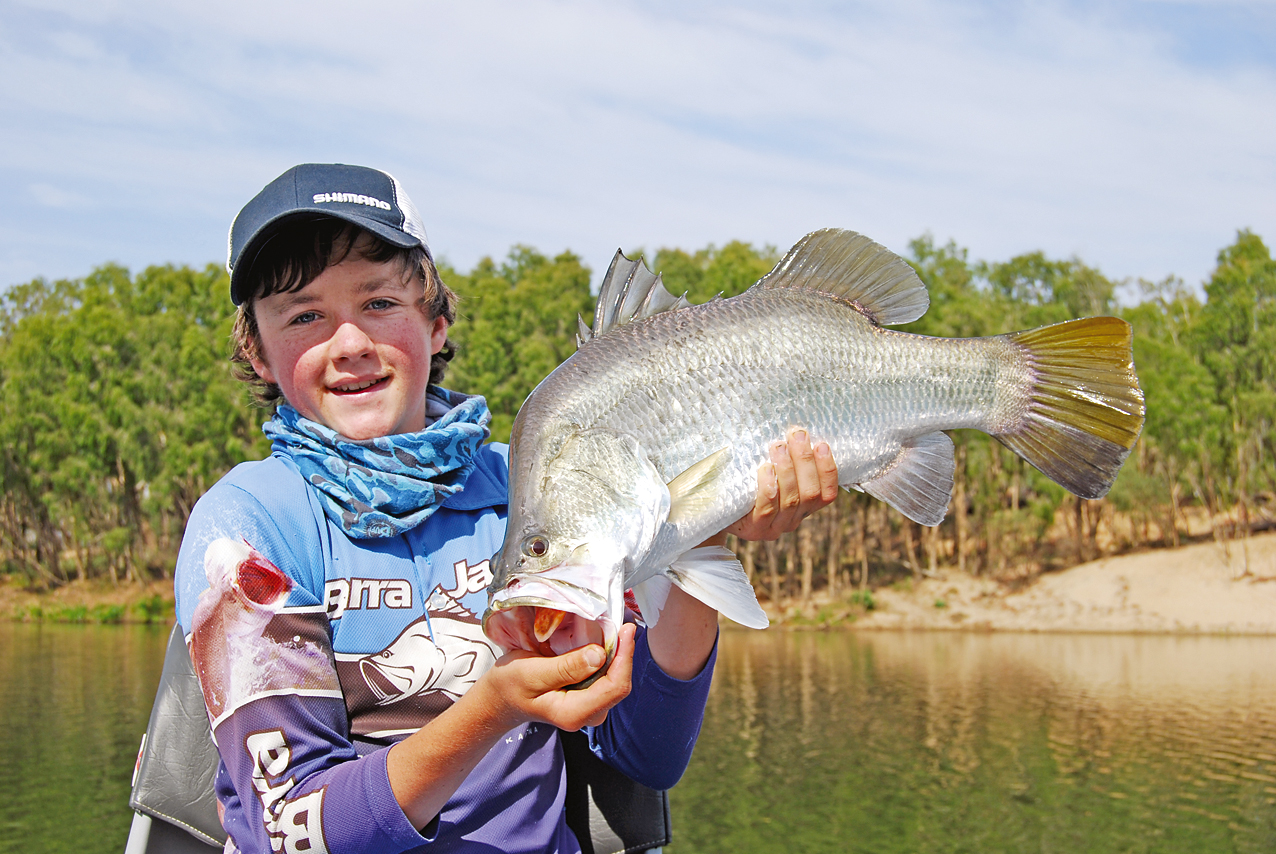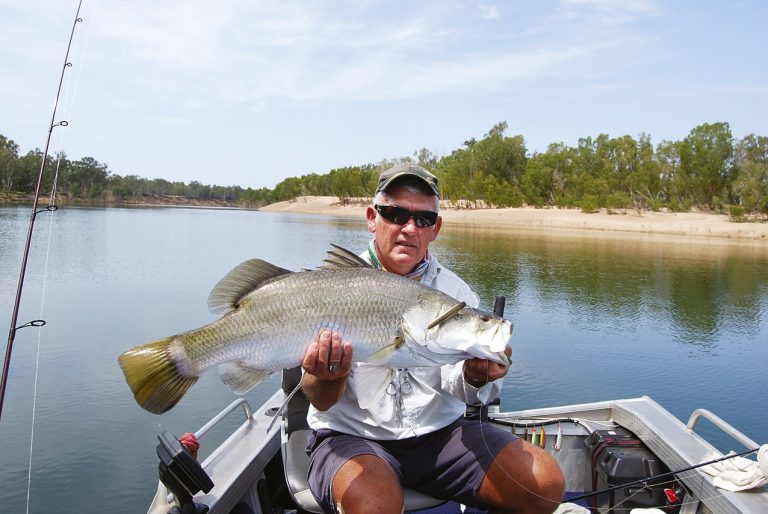Fitzroy Reflections

By Bill Bowtell
Fitzroy River
I often reflect on some of my most treasured moments when fishing. It might have been a special fish, or an odd catch.
It might have been a successful outcome to a well-planned trip that produced a good catch of fish, or it might have been the trip itself – with mates, or family. Whatever these reasons may be, the moments to which they refer are treasured. We all have them. And they start at a very young age.
Then there is the lead-up to such moments. I have always kept pretty good records of each of my fishing trips. In the early days these records were a comprehensive diary, of dates, moon phases, bite times, tides, baits/lures, methods, weather conditions etc. Like I said – comprehensive. In more recent times, it might be notations in my tide book accompanied by a single note page if necessary. Age and experience does have some benefits.
The “wet-season” of 2008-09 in Central Queensland was a massive and memorable event right across the individual catchments that make up the major river system of the region – the Fitzroy. It was massive on two accounts. Firstly, the amount of rain that was dumped throughout the extended wet season. And secondly, how widespread this rainfall was. In the circumstances of the Fitzroy, it was right across the catchment, and caused major and prolonged flooding throughout the lower basin and delta.
It was memorable on one account – the deluge and following flood occurred on the back of a ten-year drought, so the flood gave life back to the river. Fish numbers exploded. Fish of all species, shapes and sizes bred and could be seen in their millions moving through the floodwaters. Every backwater, gully, channel, stream had schools of fish on the move. Lagoons, billabongs, creeks and gullies that were previously dry, or hadn’t run for years, were now lost in the inland sea that was once the Fitzroy.
Man-made barriers were no longer functional as floodwaters swept around, and over, them to follow old flow paths and the fish followed. Moving well upstream into old, and traditional, waterways of the upper Fitzroy catchment. An event, and set of circumstances, not lost on the local fishers and local infrastructure administrators. Barramundi in their thousands moved up into these areas, which for so long had been barred by the Fitzroy River Barrage at Rockhampton.
Over the next four years as these fish grew out to maturity the fishing was exceptional in those freshwater areas immediately above the barrage and truly showed what a great asset it would be to fishers and the community if it could be maintained. BUT! It wasn’t just about community and fisher’s expectations. It was about the fish themselves.
I first got wind of the barra fishing to be had above the barrage in early 2012, approximately three years after the 2008-09 flood event. I knew the recruitment during the ’08 spawning months was exceptional as I not only witnessed it first hand, being out in the flood waters (taking recordings) as part of my job as a surveyor, but also from discussions with long time mate and Director of Infofish, Bill Sawynok, who runs the “Crystal Bowl Project”. This unique, and long running project looks specifically at the life cycle of the barramundi in CQ, with much of the focus on the Fitzroy River. Bill’s sampling at this time indicated the best recruitment in more than 15 years of sampling. That the flood event allowed fish movement well upstream beyond the Rockhampton Barrage was the icing on the cake. And the fish, especially the barramundi, responded.
The first trip up into the freshwater reaches was truly nothing more than a test run for my mate, Kim Martin, and myself. We are both experienced fishers, but experience doesn’t really account for much when confronted with more than 50 kilometres of seemingly productive waterway strewn with weed beds, fallen timber, sand and rock bars and long shady stretches of dense overhanging ti-tree. Fish could be anywhere – or everywhere! We found plenty and landed 15 magnificent barra on that first day.
These fish were all mature fish between 630mm and 930mm – a direct result of the 2008–’09 recruitment and mass upstream migration. They were big, strong, muscular and full of fight. That we lost six lures on that first day showed that 20lb braid just wasn’t going to be a long-term solution to the bank account. I upgraded to 50lb the next trip and still got blown away four times in four casts at a snag we rightly called “Suicide Fork” – a large fork in the trunk of a submerged river gum. One simply threw into there and hung on! Exciting but expensive! The late Ken Richardson loved me. But it was about the fish!!!
Throughout late 2012 the weather built up into a typical pre-wet season pattern – hot and humid mornings, early cloud convection with mists and fogs along the inland waterways. In the afternoon clouds would gather in the west as if a storm was prevalent. Then it would all dissipate as the afternoon northerlies kicked in. Great weather for barra fishing. Trips “up the river” were frequent. There was much exploring done.
This exploration was not just about catching fish. Even though convincing someone that 126 barra, between 630mm and 975mm tagged and released and a further 12 destined for the table was not about catching fish, might be a bit hard and an understatement in itself. But there was more to it.
More than 50 kilometres of river upstream of the Rocky Barrage was checked for barra and fish were caught along the entire stretch. We could have gone further but didn’t. I know the results would have been the same. Apart from barra, we caught tarpon, catfish, sooty grunter, saratoga and a solitary mullet that absolutely belted a pink Richo “Extracta 9” and performed as well as any barra. We saw schools of garfish, boney bream, grunters of all descriptions, as well as more mullet. The river was alive and much of it, no, most of it, was due to the flood. It was about the fish.
It would be easy to get philosophical here, but I won’t. For there are too many other factors and considerations for discussion before an outright statement could be made. And I like to think that I am an intelligent enough person with enough experience to first consider all facts before forming an outright opinion. But here are some facts from a fisherman’s perspective worth noting:
- The build-up to the 2008-09 wet-season provided ideal spawning and breeding conditions for the barramundi at the peak of their local breeding season October – December. It was noted and reported by Bill Sawynok in his “Crystal Bowl” Project (CBP).
- The flood event of the 2008-09 wet seasons inundated the Fitzroy River flood plain for three months. Also noted by those authorities responsible for infrastructure development.
- This flood event was major and circumvented the barrier effect of the Rockhampton Barrage.
- Juvenile barramundi which filled the nursery areas in their thousands (and other species such as tarpon, mullet, garfish) used this flood event to venture well upstream via a series of lagoons, connecting waterways and creeks to enter the Fitzroy proper beyond the barrage barrier.
- These fish (notably the barramundi) over the next four years grew to maturity in these fish rich waters. And did so in the most natural of circumstances. A point of prediction in the CBP and noted by fisheries and city administrators.
- Given even a moderate flow in the Fitzroy, these mature fish could/would/did migrate downstream, then pass through the barrage gates and form part of the spawning biomass at the mouth of the river. An age-old ritual for these fish.
- Given the same moderate flood event barra do not migrate en masse beyond the barrage. Conditions are not right for their passage and they literally don’t go! Consecutive studies show this time and time again.
As stated earlier, there are other factors to consider. None more so than the guarantee of a quality water supply for the City of Rockhampton. But it does come at a price to the fish.
Rockhampton is now undergoing major infrastructure works on road and rail to “flood proof”, access wise, the city. These infrastructure works are directly across the old and traditional Fitzroy flood plain. There is a cry from within industry to make more land available for services and much of this is adjacent to the flood plain. There are reasons for concern.
We know that the barra will use the flood plain, and its age-old waterways, in times of prolonged major flooding. We also know that these events occur only about once every 20 years. We also know that a moderate (say 1 in 5 year) flood event will allow fish like barra to migrate downstream, but will not allow upstream movement. It therefore stands to reason that should fish get upstream following major flooding in the system then they will be gone within five years maximum. Then the system lies devoid of fish such as barramundi for the next fifteen years on average. And this is if the environmental status quo remains.
From personal experience it could be suggested that the waterways upstream of the Rockhampton Barrage would support better than a million dollar per year recreational fishery based on tourism alone. But it would need the will of the city administrators and infrastructure developers. Chook raffles, part government donations and a lot of community free support is putting some fish back into the system. But in reality it is a punitive effort to what nature can do in one hit, if allowed and given a helping hand at regular intervals.
On average, barra have a major spawning cycle about every four to five years. On average, nature provides us with a moderate seasonal event about every five years. Get the picture? Now, if we can only combine the two sets of data (and yes, it is all there, and has been for a long time!), then maybe, just maybe, we can use those old waterways to provide guided passage around the barrage for the barra, without losing any of the integrity of the water storage capability of the barrage itself.
Ever heard of natural flows and locks? Barra will punch through fast flowing waters but need a place to rest. It can be done. And the very flat nature of the Fitzroy floodplain means that such an exercise is a relatively simple affair. But there has to be the desire. And this has to come from the fishers and the community. It really is for the fish.
How nice it would be to reflect on treasured moments of drifting the river in the company of tall river gums and paper barks; of nearly having your rod pulled from your hands as a metre-plus fish belts your lure, before heading skywards. It is tagged and released. And you reflect again.

Nathan Brown with a nice barra taken along the edge of a line of ti-tree in 6m of water





